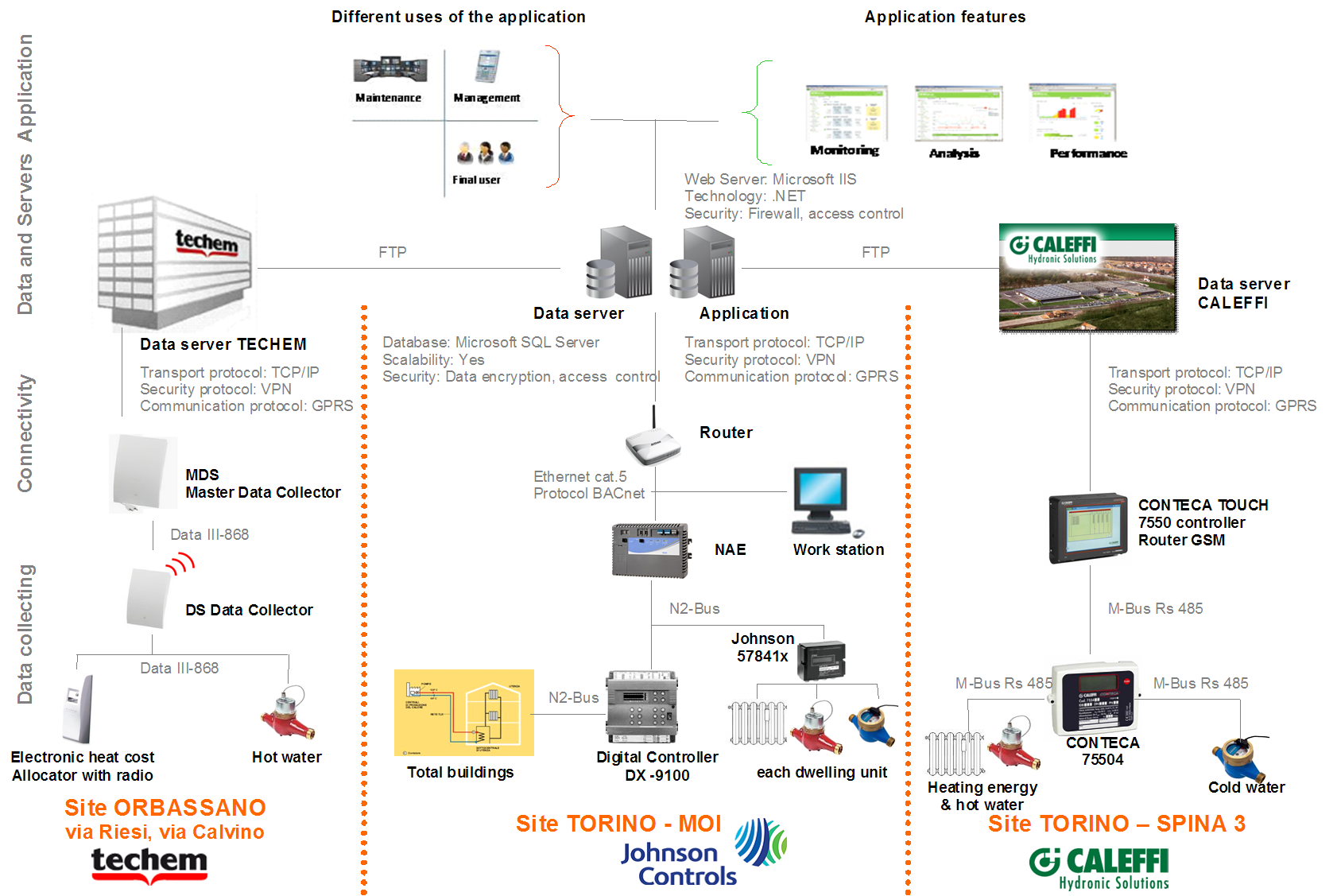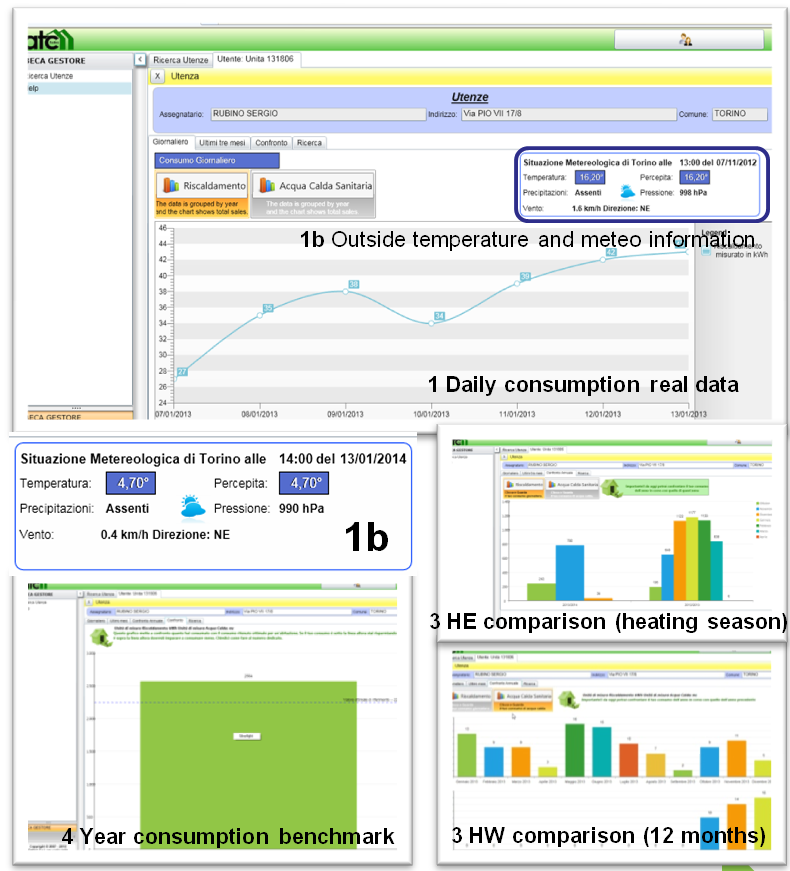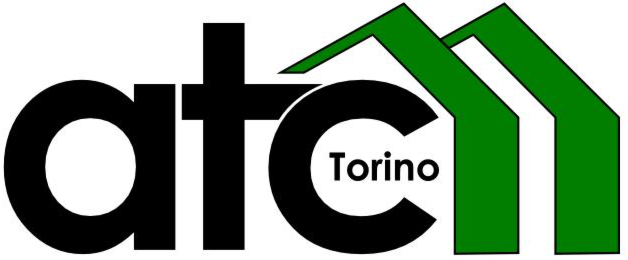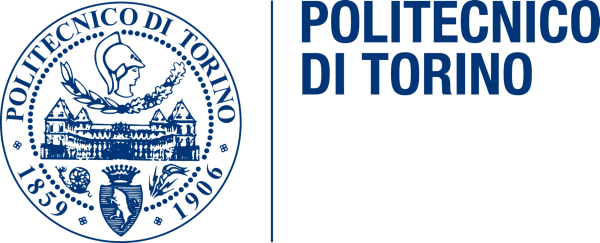Turin¶
Video – Savings – Service – Cost-Benefit – Exploitation – Partners
The pilot site Torino (Italy) includes two urban neighbourhoods, MOI in the south of the metropolitan Turin area and Spina3 in the north side and part of a suburb of Orbassano in via Riesi and via Calvino. The three buildings with 697 dwellings have a total surface of about 44,606.60 m² (size from 30 m2 to 90 m2). In MOI and Spina3 the buildings were built between 2003 and 2006: In Orbassano they were already built in the late 1980s; however they have been under renovation between 2005 and 2009. The buildings vary in energy performance from high (MOI and Spina3) to medium (Orbassano).
Three measurement and control systems from service providers Johnson, Caleffi and Techem, are used in the pilot. Initially all service providers agreed on allowing ATC to use the data collected by their systems in an unified and common portal without further interaction necessary during the process of data download. During project implementation some issue arose principally regarding Caleffi. At present, Caleffi gives in fact permission to ATC to acquire the data but does not provide for on-line transmission of data. To acquire automatically the data from Caleffi requires an onerous transaction that cannot be sustained with the project funding. Further to negotiations with Johnson and Techem, at present all data are being sent to ATC server and migrated to ATC portal. To fully enable the functionality of tenant facing web-services and the Energy Management Services (ems), system upgrades were implemented.
Video¶
Savings¶
The results for heating vary depending on the system provider from 0.4% to 7% - above you can see the total for the entire site. For more details visit the eeMeasure tool and the BECA deliverable D7.2 also covering qualitative surveys.
Service¶
ATC integrated three ems from three different providers under one platform creating one homogenous experience for tenants who often move between buildings (and systems).
 Portal¶
Portal¶
If you are interested in the portal you can request a public access from ATC for the portal.
edss¶
All tenants (in all three sites) have been able to access the new web portal to check their consumption (heating and hot water). The access was granted by inserting PW and Username. The real IT knowledge in ATC social housing has been evaluated in order to estimate a real perspective of portal use in the pilot site. From past experience on web based services from ATC to tenants, it has been detected that the use of internet is quite common in general. ATC offers a range of services on line through his web page such as: newsletter; dwelling exchange list; new housing calls for allocation or booking service for dwelling exchange and sales.
The access to BECA portal has been provided through the ATC web portal (already known to the tenants) instead of creating a new tool. In order to enable tenants of social housing to access to an ATC portal, it was compulsory to follow a strict procedure, as accessing to the reserved area of ATC portal may cause frauds (the ATC portal is linked to the main database that contains also sensible data). The above mentioned procedure previews, required the submission to ATC of personal information such as social security number, name and email address of the applicant for the service activation. In writing the letters to tenants ATC also included the option to replace the e-mail with the mobile phone number for those who do not have an e-mail account. It is in fact common to have a Smartphone more than computers at home. ATC provided tenants with an initialization password that should be changed by the user after the first access and the user name was the security number of the tenant.
In 2011, it was possible to see only the monthly consumption, but in 2013 daily monitor of tenants’ consumption (heating and hot water only) was made possible by ATC. Tenants/users also received information on energy consumption in the bill (separate letter sent with the bill not directly on the billing certificate because it is impossible to change the format of the bill). Tenants were directly contacted in case any abnormal consumption was detected.
- (CASE 1) It was possible for all tenants, from the three pilot sites, to request information about the status of their consumption to the call centre by calling (tool already available for other users’ needs). The staffs were trained to provide appropriate responses.
- (CASE 2) Installation of a computer station with connection to the web portal at the offices of ATC. Application was installed to control accesses the portal from that PC apart from the access provided at home for selected tenants. (1st phase).
- (CASE 3) Alarms. Users reported any anomalies on excessive energy consumption through the medium of communication preferred by the tenant (SMS later on, e-mail, phone call).
ems¶
- Orbassano (Techem, see also Darmstadt for more detail)
- Activation of the reading system and remote monitoring of heating and DHW consumption for all dwellings (daily);
- Controls annual fuel consumption of heat generator for heating and domestic hot water;
- Annual inspection of the thermal energy delivered to the building for heating and domestic hot water;
- Optimisation of energy consumption for heating and domestic hot water by installing electronic devices (adapterm from Techem).
- District MOI (Johnson Controls)
- Activation of the reading system and remote monitoring of heating and DHW consumption of housing (daily);
- Monitoring of monthly Cold Water consumption;
- Monthly control of thermal energy delivered to the building for heating and domestic hot water;
- Optimisation of energy consumption for heating and domestic hot water with a streamlined management of the plants through the Johnson Controls Metasys;
- Integrated Management of plants from a distance, through the supervision system of Johnson Controls Metasys with the possibility of sending automatic alerts to the manager.
- District Spina 3 (Caleffi)
- Enabling remote reading system, and daily monitoring of the joint consumption of heating and DHW;
- Monthly control of thermal energy delivered to the building for heating and domestic hot water
Value propositions¶
The key strength is the ability to handle data coming from various building management systems which are not directly compatible. BECA is not only able to handle and visualise the data but also to understand any differences arising as a result form different standards / methods used. The tool serves professional users as much as it serves tenants. Professional are provided with one platform for day-to-day monitoring, central setting of standardised alarms while being able to dig deeper in the designated building management system on the same desktop. The centralisation is cutting overhead and response-time and improves motivation to find ways to optimise systems further as a wide range of tasks does no longer need to be repeated. In this context, it also provides the housing company with one central platform to communicate with tenants. Tenants are now able to monitor their consumption and communicate any technical problem via the platform. By adding transparency, BECA helps to ease the difficult relations between the social housing provider and the tenants, especially in cases of high consumption detected. Finally, one energy management system was upgraded with Adapterm improving energy efficiency.
Cost-Benefit¶
The path for socio-economic return is almost steadily increasing and mostly driven by savings by Tenants. Since the site is large, certain costs are distributed across many dwellings (compared to other sites) leading to immediate pay-off. The benefits for the Social Housing provider are resulting from administrative and organisational improvements of which only measurable items (no estimates for overhead) have been included in the calculations. The Tenant has almost no cost: A fee for the service (if legally possible) could shift some benefits enabling further deployment in other dwellings. As the installed solutions vary (across Turin sites), only half the potential savings for heating have been used in the CBA. On the other hand, development cost for the portal is not included as this is to cover larger parts of the building stock in the future.
Exploitation¶
BECA enables ATC to standardise energy consumption data collection in a more efficient manner across the entire building portfolio of all developments capable will be integrating in the system in the near future. Upcoming energetic retrofitting programs will include more versatile technology capable of further integrating the BECA solution for tenants and professionals. The transparency enabled by BECA and the tenant platform will be exploited across / between departments. Finally, 30 data loggers are being monitored by PoliTO to research opportunities for future improvements. ATC [1] is communicating with numerous housing (especially in the North of Italy). The goal is not only to provide the companies with the solution but to also standardise certain procedures across participants (e.g. billing measures) adding value to BECA while providing various other benefits creating massive overheads in housing companies.
Partners¶
Agenzia Territoriale per la Casa della Provincia di Torino - ATC , was established in 1907 by the Torino City Council to supply underprivileged citizens with low-cost housing and at the same time administering and managing their own real estate and that entrusted to them by other public bodies.
EXE.GESI has been established as an energy service company by ATC Torino in 2002 for building plants and heating management. EXE.GESI manages around 300 heating boilers and plants, and 1100 lifts, mainly in social housing stocks and provides planned and extraordinary maintenance of heating plants of ATC Torino (more than 700 buildings in the Province of Torino). Additionally EXE.GESI is involved in activities related to district heating, cogeneration and renewables.
Department of Electrical Engineering at the Politecnico di Torino - POLITO is a leading public research university founded 150 years ago dedicated to theoretical & applied research with 170,000 teaching hours per year, 26,000 students with 115 courses (39 Bachelor’s degrees; 35 Master of Sciences; 23 Doctorates and 18 specialisations). Thee university research is organized in 18 departments and 12 service centres.
POLITO has a strong reputation in research and education on sustainable technologies and renewable energies. With more than 800 research contracts with public institutions and industries worldwide, POLITO cooperates with various international research centres, industrial partners, local authorities and utilities. It hosts the Business Research Centre, where offices, laboratories and services are available to companies interested in starting up and developing a research structure and where they can receive valuable services such as tutoring, administrative and management consultancy, and streamlined access to credit and venture capital.
| [1] | With regard to ATC Torino it is necessary to remark that ATC, being a statutory body, cannot derive economic benefits (in terms of profit) managing real estate of social housing in the Province of Turin. ATC Torino operates with the assistance of five in-house firms including a software services provider and an energy services management company. |








